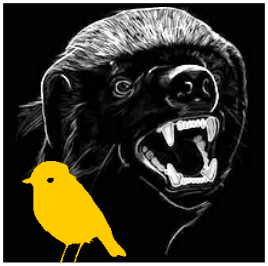The fossa, a civet-like species from Madagascar, is an exception proving a hidden rule: that the clitoris functions mainly for scent.

Prof. Mumblebard claims: “The clitoris is a developmental vestige of the penis, functioning as a sense organ during copulation, and it is well-developed only in those species which – because of their female-dominated societies – have an unusual amount of testosterone in the female. The proportionately large size of the clitoris in some mammals is not adaptive as much as collateral: a symptom of an unusual degree of hormonal androgenisation in the species concerned.”
Robin and the Honey Badger respond: “In various species of mammals the elongated clitoris is unlikely to be stimulated by the male, either in courtship or by the penis during copulation. This is epitomised by the fossa, a civet-like species which is the largest native carnivore on the island of Madagascar. In the fossa, the clitoris is penis-like only in the juvenile female after weaning and before sexual maturity. This ‘tween’ period lasts several years because of the particularly slow growth of the fossa, a predator which depends on slow-growing lemurs for its food. What is most remarkable about the fossa is that, although the flaccid clitoris is housed in a labial pouch, it grows both a clitoral bone and a complex spiny head that are largely resorbed when sexual maturity is reached, at which time the clitoris shrinks permanently for the breeding life of the female. This means that in maturity as in infancy, the clitoris is small, but at the juvenile stage the erect clitoris is as long as, and more complicated than, the human penis. Because the full-size clitoris of the fossa is not involved in copulation but is well-designed for scent-marking, it shows in extreme form an adaptive principle hidden in plain sight which applies to varying degrees in all mammals. This is that the mammalian clitoris is used for social scenting more consistently than for sexual stimulation.”

Please join us here at the Bio-edge with your own comments. In the discussion below we encourage links to any evidence supporting either Prof. Mumblebard or Robin and the Honey Badger. Illustrations are welcome but please cite all sources or we may be forced under copyright to delete your comment.
![]() “In other words”
“In other words”

